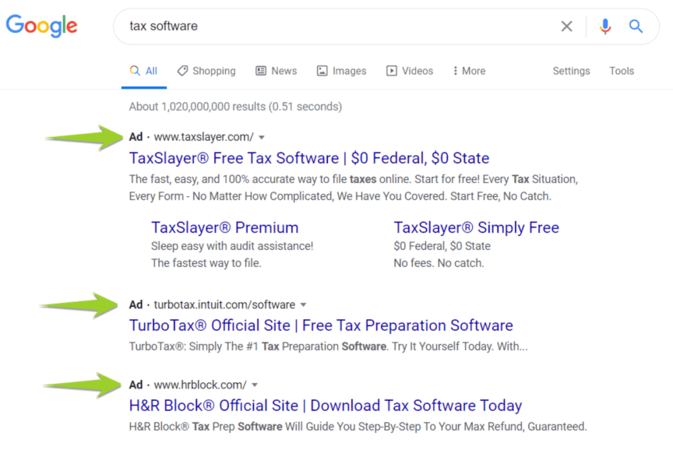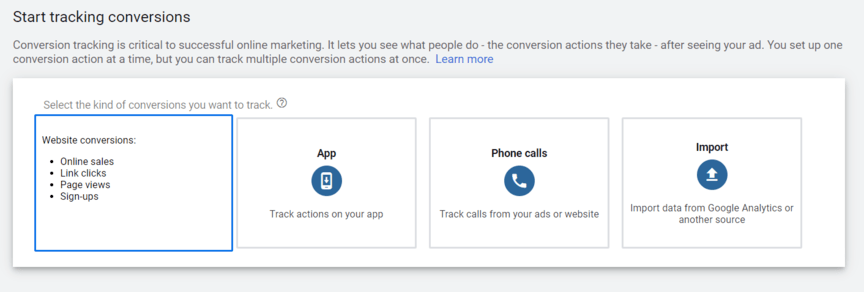-
 6 min. read
6 min. read
-
 Sarah Berry
Sarah Berry Web Marketing Consultant
Web Marketing Consultant
- Sarah Berry is a Google Analytics-certified Web Marketing Consultant at WebFX. She’s written over 400 articles on digital marketing, covering topics like SEO, CRO, and Amazon. When she isn’t polishing her Time Magazine Person of the Year Award, she’s spending time with her flock of ducks.
Return on ad spend (ROAS) for Google Ads is one of the most difficult metrics to measure, especially across an industry, because it requires businesses to share how much they spent on Google Ads and how much they earned from their ads.
CALCULATOR: CALCULATE YOUR ROAS INSTANTLY!
While you probably won’t find an average ROAS by industry for Google Ads, you can look at some data from Google Ads, like ad spend and return on investment (ROI), to get a general benchmark for your company.
Hint: That benchmark is 200% — a 2:1 ROAS, or an average return of $2 for every $1 spent. If you’re curious to learn more about the data behind this ROAS benchmark for Google Ads, keep reading! You’ll also learn how to calculate ROAS and what to watch for when calculating your company’s ROAS for Google Ads.
How to calculate your ROAS from Google Ads
No matter how you calculate ROAS from Google Ads, whether with a calculator or pen and paper, it’s crucial to understand how ROAS gets calculated.
It helps you know what ROAS measures, as well as whether you earned a positive or negative ROAS from Google Ads. The ROAS formula is:
ROAS = Total Ad Revenue / Total Ad Spend
In some cases, you’ll see the ROAS formula formatted as follows:
ROAS = Total Ad Revenue / Total Ad Spend * 100
This formula formats your ROAS as a percentage by multiplying your result by 100. If you use this version, know that a positive percentage, like 50%, doesn’t equal a positive ROAS because you’ve only earned 50% back on your investment. Your ROAS must exceed 100% for your business to make a return on its ad spend.
What is the average ROAS for Google Ads?
The average ROAS for Google Ads is 200%, which translates to earning $2 for every $1 spent. You can also calculate this amount by looking at some publicly available Google Ads data, like:
- What the average company spends on Google Ads
- What the average company earns from Google Ads
The average business, for example, spends $9000 to $10,000 per month on Google Ads and earns $2 in revenue for every $1 they spend on Google Ads. If they focus on the Google Search Network, that amount increases to $8 for every $1 spent. This information provides the “Total Ad Spend” for the ROAS formula — $9000 to $10,000. It also offers data to calculate “Total Ad Revenue” for the ROAS formula — $2 for every $1 spent. If the average business earns $2 for every $1 spent, and they invest $9000 to $10,000 per month, that means they’re earning around $18,000 to $20,000 in revenue from Google Ads each month. You can calculate this value by multiplying $9000 and $10,000 by $2. Now, you can take this data and input it into the ROAS formula:
ROAS = Total Ad Revenue / Total Ad Spend * 100
ROAS = $18,000 / $9000 *100
ROAS = 2 * 100
ROAS = 200%
The result is 200%, meaning you’re earning $2 back for every $1 you invested into Google Ads.
What is the average Google Ads ROAS for my industry?
Calculating the average ROAS by the industry for Google Ads is a challenge for a few reasons. Most companies, for example, aren’t comfortable sharing their ad spend or ad revenue. For accurate ROAS industry benchmarks, you need a decent and diverse sample size, which means you need a significant number of businesses, both small and large, to share their ad spend and ad revenue.
If you don’t have a large and diverse enough sample size, you publish inaccurate benchmarks. Sharing inaccurate data like that can cause businesses to incorrectly measure their Google Ads performance and make decisions that harm not only their overall marketing and advertising efforts, but also their leads and sales numbers. That’s why it’s best to reference the overall ROAS average for Google Ads: 200%.
What is a good ROAS for Google Ads?
Meeting the average ROAS for Google Ads is great, but going beyond the average is even better.
When you increase your ROAS, you help your business earn even more from paid advertising, which will probably lead to a few high-fives. Generating a higher ROAS can also lead to a bigger Google Ads budget, which gives you even more room to drive results for your company. So, what is a good ROAS for Google Ads?
Anything above 400% — or a 4:1 return.  In some cases, businesses may aim even higher than 400%. Remember, Google found that companies could earn an average return of $8 for every $1 spent on the Google Search Network.
In some cases, businesses may aim even higher than 400%. Remember, Google found that companies could earn an average return of $8 for every $1 spent on the Google Search Network.
Since most businesses start with the Google Search Network, which delivers ads to places like Google search results, it makes sense to set more ambitious ROAS goals.
3 things to know about calculating ROAS for Google Ads
While ROAS calculators make finding your ROAS easy, you should keep in mind a few factors, including:
1. ROAS should include all your advertising costs
When you calculate your ROAS, you enter your total ad spend. A lot of times, companies will look at this number and enter their monthly ad spend, which they pay directly to an ad network, like Google Ads. The problem, however, is that this number doesn’t include additional advertising costs.
For example, these costs can include:
- Bid management tools
- Landing page design services
- Employee salaries
Whether your business includes these numbers is up to you. For example, you may exclude employee salaries and include some bid management software that you use, which makes sense. In your company role, you probably do more than PPC management, while your bid management software gets used solely for your ad campaigns.
2. ROAS only considers the revenue generated from advertising
Next, ROAS only looks at how much revenue you generated from advertising, like with Google Ads. This approach may work well for ecommerce companies, but for lead-based businesses, ROAS can provide an inaccurate perspective of your Google Ads ROAS. That’s why it’s helpful to create conversion actions in Google Ads.
 With conversion actions in Google Ads, you can set custom conversions, like a quote request, and assign them a monetary value, like $250. This tool can help you monitor and measure the performance of your ad campaigns, as well as make your ROAS calculation more accurate, so take advantage of it.
With conversion actions in Google Ads, you can set custom conversions, like a quote request, and assign them a monetary value, like $250. This tool can help you monitor and measure the performance of your ad campaigns, as well as make your ROAS calculation more accurate, so take advantage of it.
3. ROAS is not ROI
While similar, ROAS and ROI are different:
- ROAS measures your average return from advertising.
- ROI measures your total return from advertising.
ROAS also takes a closer look at your advertising performance, helping you focus on the campaigns, ad groups, and ads that drove the best return for your business. If you want to measure the performance of your advertising efforts, like on Google Ads, use ROAS.
Calculate your Google Ads ROAS instantly with our ROAS calculator
Knowing the average ROAS for Google Ads is the first step. The second step is calculating your Google Ads ROAS, which is easy with our free ROAS calculator.
Just enter your total ad spend and ad revenue for a period, like a month, and our calculator will do the rest. Try it now!
If you aren’t happy with your results — and haven’t been with your Google Ads strategy overall — feel free to contact our team. You can contact us online or give us a ring at 888-601-5359 to learn how our Google Ads agency can help with your pay-per-click (PPC) strategy!
-
 Sarah Berry is a Google Analytics-certified Web Marketing Consultant at WebFX. She’s written over 400 articles on digital marketing, covering topics like SEO, CRO, and Amazon. When she isn’t polishing her Time Magazine Person of the Year Award, she’s spending time with her flock of ducks.
Sarah Berry is a Google Analytics-certified Web Marketing Consultant at WebFX. She’s written over 400 articles on digital marketing, covering topics like SEO, CRO, and Amazon. When she isn’t polishing her Time Magazine Person of the Year Award, she’s spending time with her flock of ducks. -

WebFX is a full-service marketing agency with 1,100+ client reviews and a 4.9-star rating on Clutch! Find out how our expert team and revenue-accelerating tech can drive results for you! Learn more
Try our free Marketing Calculator
Craft a tailored online marketing strategy! Utilize our free Internet marketing calculator for a custom plan based on your location, reach, timeframe, and budget.
Plan Your Marketing Budget

Maximize Your Marketing ROI
Claim your free eBook packed with proven strategies to boost your marketing efforts.
Get the GuideTry our free Marketing Calculator
Craft a tailored online marketing strategy! Utilize our free Internet marketing calculator for a custom plan based on your location, reach, timeframe, and budget.
Plan Your Marketing Budget





